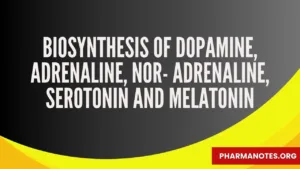Biosynthesis of dopamine, adrenaline, nor-adrenaline, serotonin and melatonin

Biosynthesis of dopamine, adrenaline, nor-adrenaline, serotonin and melatonin
Objective
At the end of this lecture, student will be able to
• Discuss the biosynthesis of dopamine, adrenaline, nor- adrenaline, serotonin and melatonin
Biosynthesis of catecholamines
• Tyrosine is the precursor for the synthesis of catecholamines, namely dopamine, noradrenaline and adrenaline
• Conversion of tyrosine to catecholamines occurs in adrenal medulla and CNS
• Tyrosine is hydroxylated to 3,4-dihydroxyphenylalanine (DOPA) by tyrosine hydroxylase, this enzyme catalyses the rate limiting reaction and requires tetrahydrobiopterin as coenzyme
• In contrast to this enzyme, tyrosinase present in melanocytes converts tyrosine to DOPA. Hence, two different enzyme systems exist to convert tyrosine to DOPA
• DOPA undergoes PLP-dependent decarboxylation to give dopamine which, in turn, is hydroxylated to produce norepinephrine
• Methylation of norepinephrine by S-adenosylmethionine gives epinephrine
• The difference between epinephrine and norepinephrine is only a methyl group
• Norepinephrine is produced in certain areas of the brain while dopamine is predominantly synthesized in substantia nigra and coeruleus of brain
Functions of Catecholamines
• Norepinephrine and epinephrine regulate carbohydrate and lipid metabolism
• They stimulate the degradation of triacylglycerol and glycogen
• They cause an increase in the blood pressure
• Dopamine and norepinephrine serve as neurotransmitters in brain and autonomous nervous system
Synthesis of serotonin
• In mammals, the largest amount of serotonin is synthesized in the intestinal cells
• Tryptophan is first hydroxylated at 5th carbon by tryptophan hydroxylase, requires tetrahydrobiopterin
as a cofactor
• 5-Hydroxytryptophan is decarboxylated by aromatic amino acid decarboxylase (PLP dependent) to give serotonin
Functions of serotonin
• Serotonin is a neurotransmitter and performs a variety of functions
1. Serotonin is a powerful vasoconstrictor and results in smooth muscle contraction in bronchioles and arterioles
2. lt is closely involved in the regulation of cerebral activity (excitation)
3. Serotonin controls the behavioural patterns, sleep, blood pressure and body temperature
4. Serotonin evokes the release of peptide hormones from gastrointestinal tract
5. lt is also necessary for the motility of GIT (peristalsis)
Biosynthesis of melatonin
• Tryptophan to Melatonin
Functions of melatonin
• It is involved in circadian rhythm of the body
• It plays significant role in sleep and wake process
• It inhibits the production of melanocyte stimulating hormone (MSH) and adrenocorticotropic hormone (ACTH)
• It also performs neurotransmitter function
Summary
• Phenylalanine & tyrosine are structurally related aromatic amino acids
• Tyrosine is a precursor for the synthesis of epinephrine, nor-epinephrine, dopamine, thyroid hormones and pigment melanin etc
• Tryptophan is a precursor for the synthesis of serotonin and melatonin
FAQs
- What role does dopamine play in the brain? Dopamine is involved in reward-motivated behavior, movement control, mood regulation, and reinforcement of learning.
- How are adrenaline and noradrenaline synthesized? Adrenaline and noradrenaline are synthesized from dopamine through enzymatic reactions in the catecholamine biosynthetic pathway.
- What is the primary function of serotonin? Serotonin regulates mood, appetite, sleep, cognition, and gastrointestinal function, contributing to feelings of well-being and happiness.
- How is melatonin synthesis regulated? Melatonin synthesis is regulated by the light-dark cycle, with levels peaking during the night, and plays a crucial role in regulating circadian rhythms and sleep-wake cycles.
- What disorders are associated with imbalances in these neurotransmitters and hormones? Imbalances in dopamine, adrenaline, noradrenaline, serotonin, or melatonin are linked to neurological and psychiatric disorders such as depression, anxiety, Parkinson’s disease, and sleep disorders.
- What are dopamine, adrenaline, noradrenaline, serotonin, and melatonin?
- Dopamine, adrenaline (epinephrine), noradrenaline (norepinephrine), serotonin, and melatonin are neurotransmitters and hormones involved in various physiological processes in the body.
- How are these molecules synthesized in the body?
- Dopamine is synthesized from the amino acid tyrosine, while adrenaline and noradrenaline are derived from dopamine. Serotonin is synthesized from the amino acid tryptophan, and melatonin is produced from serotonin.
- What are the primary functions of dopamine?
- Dopamine plays key roles in reward-motivated behavior, movement control, mood regulation, and reinforcement of learning.
- What is the difference between adrenaline and noradrenaline?
- Adrenaline and noradrenaline are both catecholamines synthesized from dopamine, but they have different effects on the body. Adrenaline is primarily involved in the “fight or flight” response, while noradrenaline acts as a neurotransmitter in the sympathetic nervous system.
- What functions does serotonin regulate?
- Serotonin is involved in the regulation of mood, appetite, sleep, cognition, and gastrointestinal function. It contributes to feelings of well-being and happiness.
- What is the role of melatonin in the body?
- Melatonin is primarily known for its role in regulating circadian rhythms and sleep-wake cycles. It is also involved in seasonal reproductive patterns and has antioxidant properties.
- How are the biosynthesis pathways of these molecules regulated?
- The biosynthesis pathways of dopamine, adrenaline, noradrenaline, serotonin, and melatonin are regulated by various enzymes, cofactors, and signaling molecules in response to physiological and environmental cues.
- What happens if there is a disruption in the biosynthesis of these molecules?
- Disruptions in the biosynthesis of these neurotransmitters and hormones can lead to neurological and psychiatric disorders, mood disturbances, sleep disorders, and other health problems.
- Can dietary factors affect the biosynthesis of these molecules?
- Yes, dietary factors can influence the availability of precursor molecules (such as tyrosine and tryptophan) required for the biosynthesis of dopamine, serotonin, and melatonin.
- Are there medications or therapies that target these neurotransmitters and hormones?
- Yes, there are medications and therapies available that target the biosynthesis, release, reuptake, or receptor activity of dopamine, adrenaline, noradrenaline, serotonin, and melatonin to treat various medical conditions and disorders.
Also, Visit:
B. Pharma Notes | B. Pharma Notes | Study material Bachelor of Pharmacy pdf




